Contents
Add two-factor authentication and flexible security policies to Meraki Dashboard SAML 2.0 logins with Duo Single-Sign On. Our cloud-hosted SSO identity provider offers inline user enrollment, self-service device management, and support for a variety of authentication methods — such as passkeys and security keys, Duo Push, or Verified Duo Push — in the Universal Prompt.
Overview
As business applications move from on-premises to cloud hosted solutions, users experience password fatigue due to disparate logons for different applications. Single sign-on (SSO) technologies seek to unify identities across systems and reduce the number of different credentials a user has to remember or input to gain access to resources.
While SSO is convenient for users, it presents new security challenges. If a user's primary password is compromised, attackers may be able to gain access to multiple resources. In addition, as sensitive information makes its way to cloud-hosted services it is even more important to secure access by implementing two-factor authentication and zero-trust policies.
About Duo Single Sign-On
Duo Single Sign-On is our cloud-hosted SSO product which layers Duo's strong authentication and flexible policy engine on top of Meraki logins. Duo Single Sign-On acts as an identity provider (IdP), authenticating your users using existing on-premises Active Directory (AD) or another SSO IdP. Duo SSO prompts users for two-factor authentication and performs endpoint assessment and verification before permitting access to Meraki.
Duo Single Sign-On is available in Duo Premier, Duo Advantage, and Duo Essentials plans, which also include the ability to define policies that enforce unique controls for each individual SSO application. For example, you can require that Salesforce users complete two-factor authentication at every login, but only once every seven days when accessing Meraki. Duo checks the user, device, and network against an application's policy before allowing access to the application.
Configure Single Sign-On
Before configuring Meraki with Duo SSO using Security Assertion Markup Language (SAML) 2.0 authentication you'll first need to enable Duo Single Sign-On for your Duo account and configure a working authentication source.
Once you have your SSO authentication source working, continue to the next step of creating the Meraki application in Duo.
Create the Meraki Application in Duo
-
Log on to the Duo Admin Panel and navigate to Applications.
-
Click Protect an Application and locate the entry for Meraki with a protection type of "2FA with SSO hosted by Duo (Single Sign-On)" in the applications list. Click Protect to the far-right to start configuring Meraki. See Protecting Applications for more information about protecting applications in Duo and additional application options. You'll need the information on the Meraki page under Metadata later.
Duo Universal Prompt
The Duo Universal Prompt provides a simplified and accessible Duo login experience for web-based applications, offering a redesigned visual interface with security and usability enhancements.
| Universal Prompt | Traditional Prompt |
 |
 |
We've already updated the Duo Meraki application hosted in Duo's service to support the Universal Prompt, so there's no action required on your part to update the application itself. You can activate the Universal Prompt experience for users of new and existing Duo Meraki applications from the Duo Admin Panel.
Before you activate the Universal Prompt for your application, it's a good idea to read the Universal Prompt Update Guide for more information about the update process and the new login experience for users.
Activate Universal Prompt
Activation of the Universal Prompt is a per-application change. Activating it for one application does not change the login experience for your other Duo applications.
The "Universal Prompt" area of the application details page shows that this application is "Ready to activate", with these activation control options:
- Show traditional prompt: (Default) Your users experience Duo's traditional prompt via redirect when logging in to this application.
- Show new Universal Prompt: Your users experience the Universal Prompt via redirect when logging in to this application.
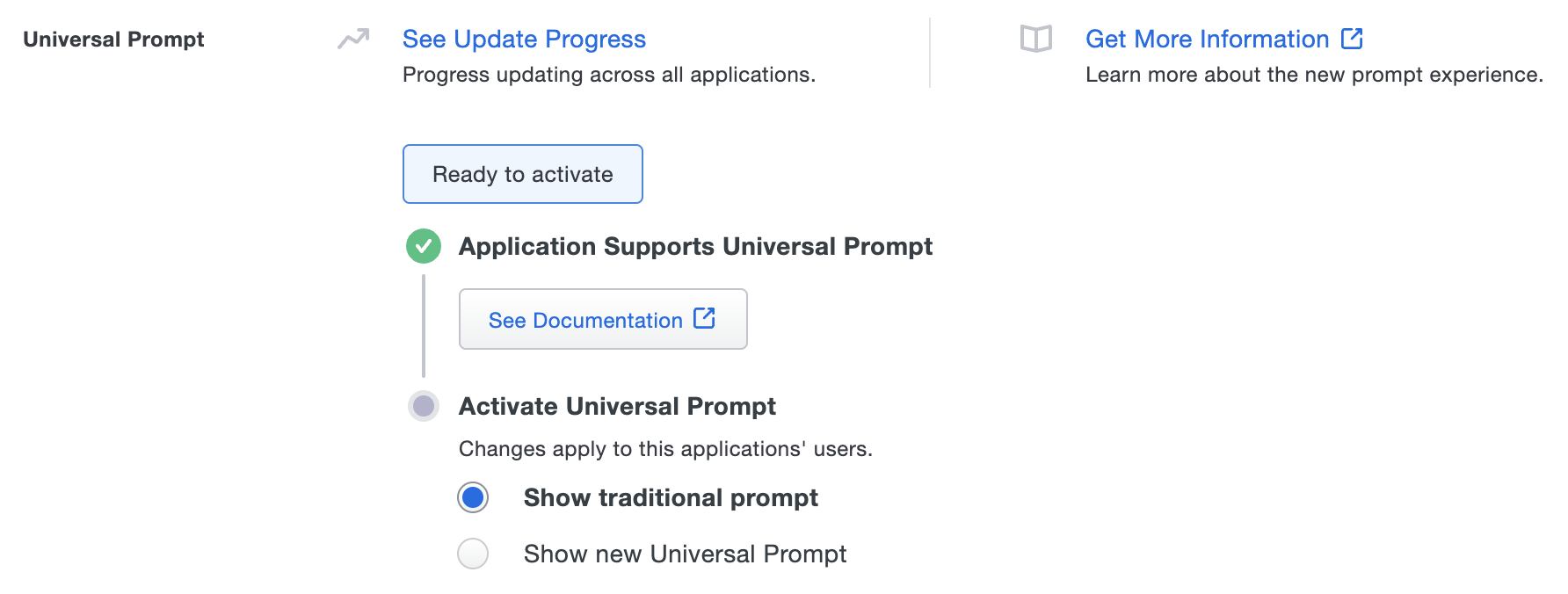
Enable the Universal Prompt experience by selecting Show new Universal Prompt, and then scrolling to the bottom of the page to click Save.
Once you activate the Universal Prompt, the application's Universal Prompt status shows "Activation complete" here and on the Universal Prompt Update Progress report.

Should you ever want to roll back to the traditional prompt, you can return to this setting and change it back to Show traditional prompt. However, this will still deliver the Duo prompt via redirect, not in an iframe.
Universal Update Progress
Click the See Update Progress link to view the Universal Prompt Update Progress report. This report shows the update availability and migration progress for all your Duo applications. You can also activate the new prompt experience for multiple supported applications from the report page instead of visiting the individual details pages for each application.
Enable Meraki SSO
Add Duo SAML Provider
Add Duo Single Sign-On as a new SSO provider for Meraki.
-
Log on to the Meraki Dashboard as an administrative user and navigate to Organization → Configure → Settings.
-
Scroll down until you find Authentication.
-
In the SAML SSO drop-down select SAML SSO enabled the setting will automatically expand.
-
Make note of the Consumer URL — you will need this information later.
Example: https://n000.meraki.com/saml/login/xx000x
-
Copy the X.509 cert SHA1 fingerprint from the Duo Admin Panel Certificate Fingerprints section and paste it into the Meraki X509 cert SHA1 fingerprint field.
-
Copy the SLO logout URL from the Duo Admin Panel Metadata section and paste it into the Meraki SLO logout URL (optional) field.
Example: https://sso-abc1def2.sso.duosecurity.com/saml2/sp/DIABC123678901234567/slo
-
After you've entered all the required information scroll down and click Save Changes.

Create Meraki Role for SAML
Next, create a SAML role in Meraki that uses the SAML provider you just created, and grant Meraki service and resource access to that role.
-
In the Meraki console navigate to Organization → Configure → Administrators.
-
Click the Add SAML role button.
-
Enter a role name in the Role field. Add organization access and permissions to this role as needed. Click the Create admin button when finished.
-
Click Save changes on the "Administrators" page.
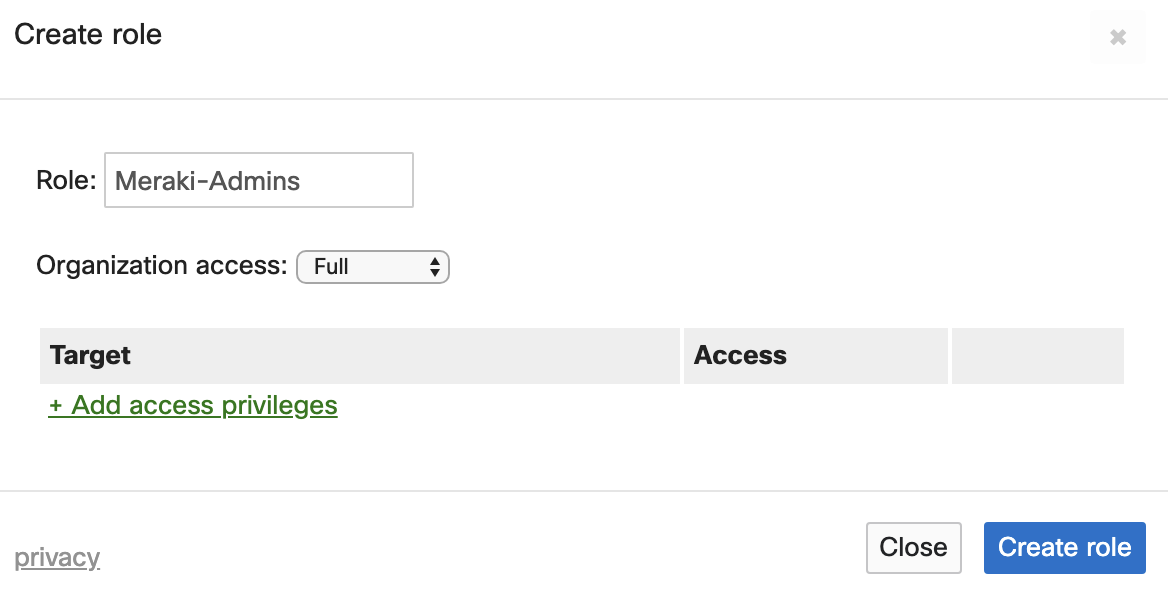
Learn more about Meraki SSO at Meraki Support.
Update the Meraki Application in Duo
-
Return to the Duo Admin Panel with the Meraki application open. Find the Service Provider section.
-
Copy the Consumer URL from Meraki SAML Configuration settings page into the Consumer URL field inthe Duo Admin Panel.
Example: https://n000.meraki.com/saml/login/xx000x
-
Under Role attributes you can type the name of the Meraki role you defined earlier in the Meraki Role field and which users should have access to that role by selecting Duo groups in the Duo Groups field. The members of those groups will be given access to that role in Meraki.
-
If you have additional Meraki roles you can click the + button next to the "Duo Groups" field to add additional rows.
-
Meraki uses the Mail attribute when authenticating. We've mapped the <Email Address> bridge attribute to Duo Single Sign-On supported authentication source attributes as follows:
Bridge Attribute Active Directory SAML IdP <Email Address> mail Email 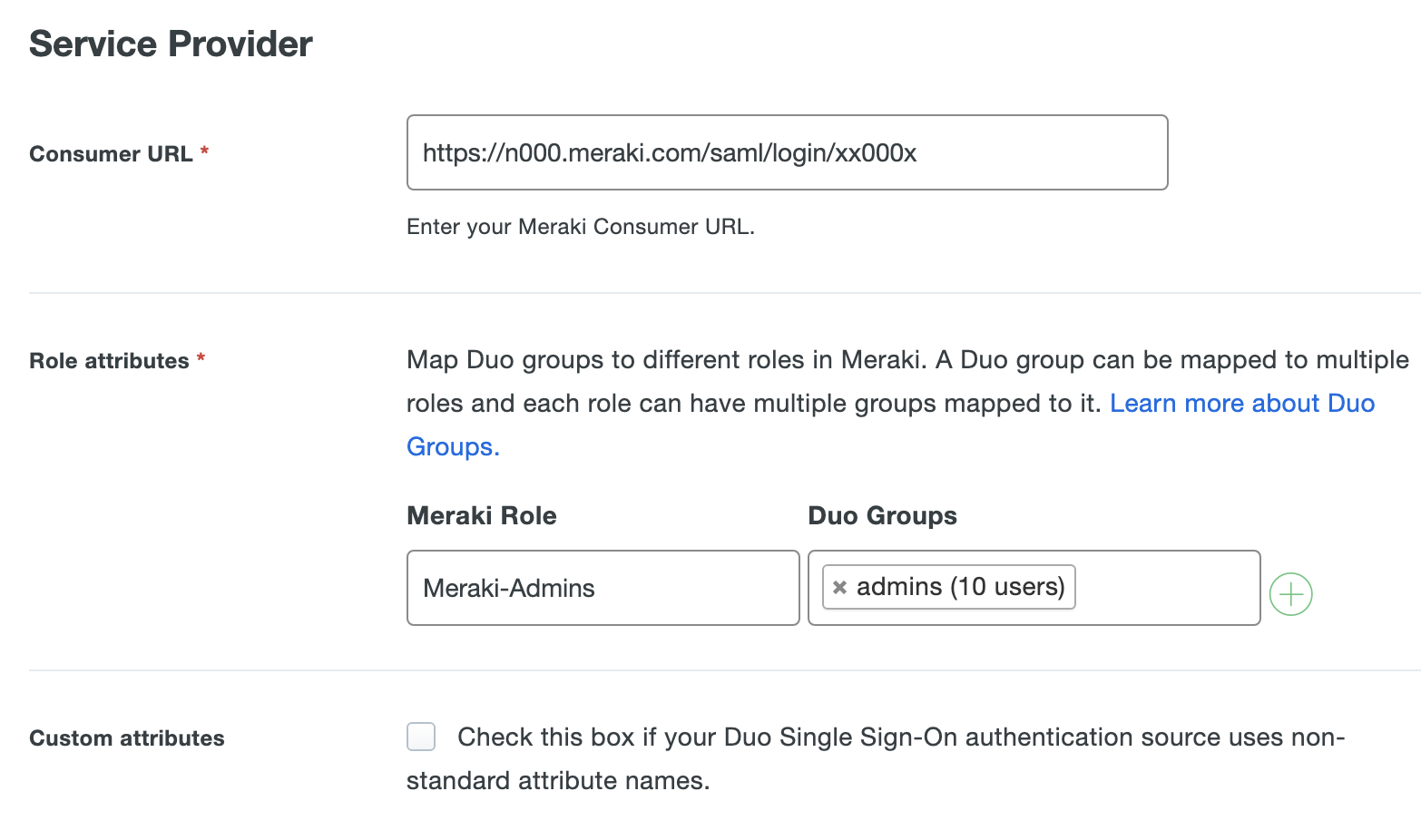
-
You can adjust additional settings for your new SAML application at this time — like changing the application's name from the default value, enabling self-service, or assigning a group policy.
-
Scroll to the bottom of the page and click the Save button.
Verify SSO
You can log into Meraki using Duo Central, our cloud-hosted portal which allows users to access all of their applications in one spot. Link to Meraki in Duo Central by adding it as an application tile. Once the tile has been added, log into Duo Central and click the tile for IdP-initiated authentication to Meraki.
You can also log on to Meraki using the Duo SSO IdP-initiated Login URL provided under the "Metadata" section of the Meraki application in the Duo Admin Panel (https://sso-abc1def2.sso.duosecurity.com/saml2/sp/DIABC123678901234567/metadata).
Active Directory Login
With Active Directory as the Duo SSO authentication source, enter the primary username (email address) on the Duo SSO login page and click or tap Next.
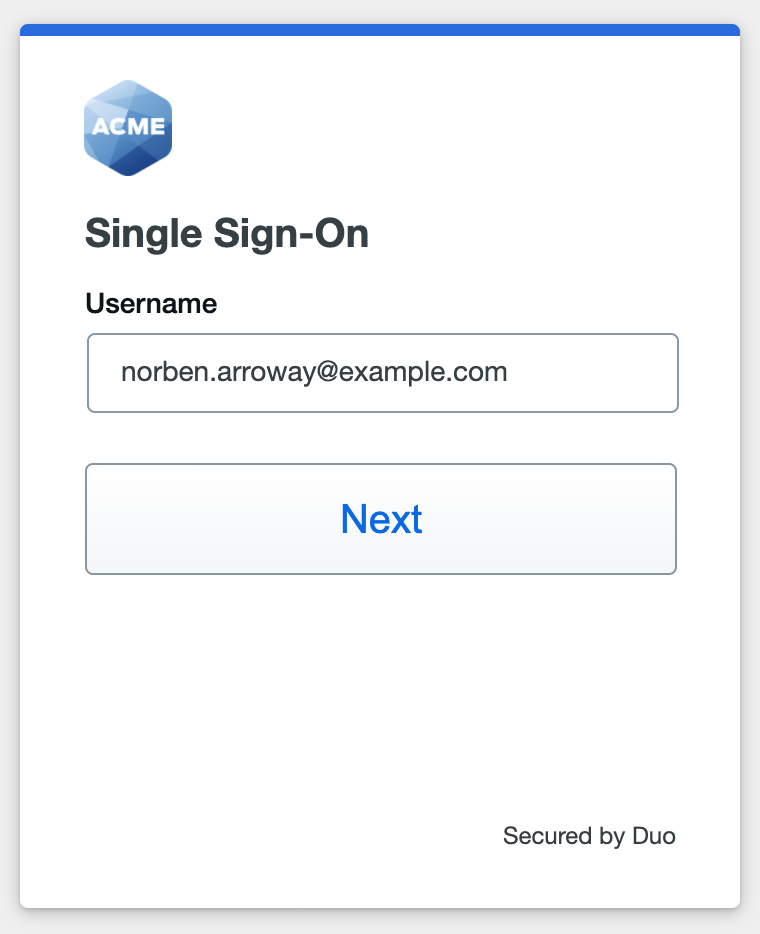
Enter the AD primary password and click or tap Log in to continue.
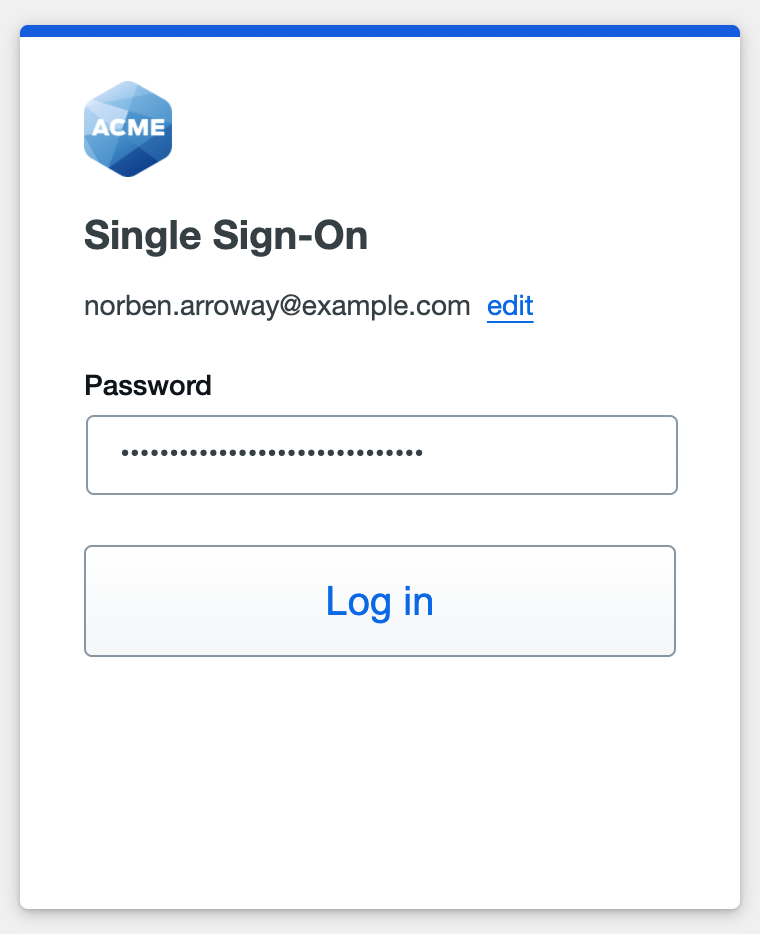
Enable Duo Passwordless to log in to Duo SSO backed by Active Directory authentication without entering a password in the future.
SAML Login
With another SAML identity provider as the Duo SSO authentication source, Duo SSO immediately redirects the login attempt to that SAML IdP for primary authentication. Users do not see the Duo SSO primary login screen.
Duo Authentication
Successful verification of your primary credentials by Active Directory or a SAML IdP redirects back to Duo. Complete Duo two-factor authentication when prompted and then you'll return to Meraki Dashboard to complete the login process.
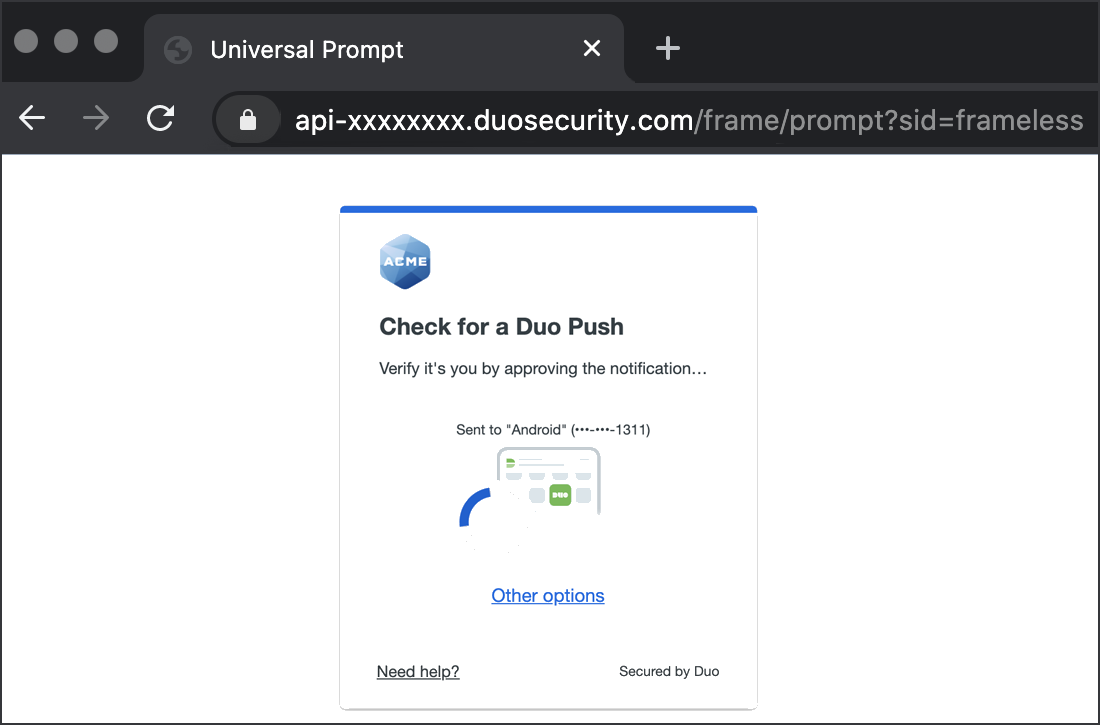
* Universal Prompt experience shown.
You can also log into Meraki using Duo Central, our cloud-hosted portal which allows users to access all of their applications in one spot. Link to Meraki in Duo Central by adding it as an application tile. Once the tile has been added, log into Duo Central and click the tile for IdP-initiated authentication to Meraki.
Congratulations! Your Meraki Dashboard users now authenticate using Duo Single Sign-On.
See the full user login experience, including expired password reset (available for Active Directory authentication sources) in the Duo End User Guide for SSO.
Enable Remembered Devices
To minimize additional Duo two-factor prompts when switching between Meraki and your other Duo Single Sign-On SAML applications, be sure to apply a shared "Remembered Devices" policy to your SAML applications.
Troubleshooting
Need some help? Try searching our Knowledge Base articles or Community discussions. For further assistance, contact Support.
